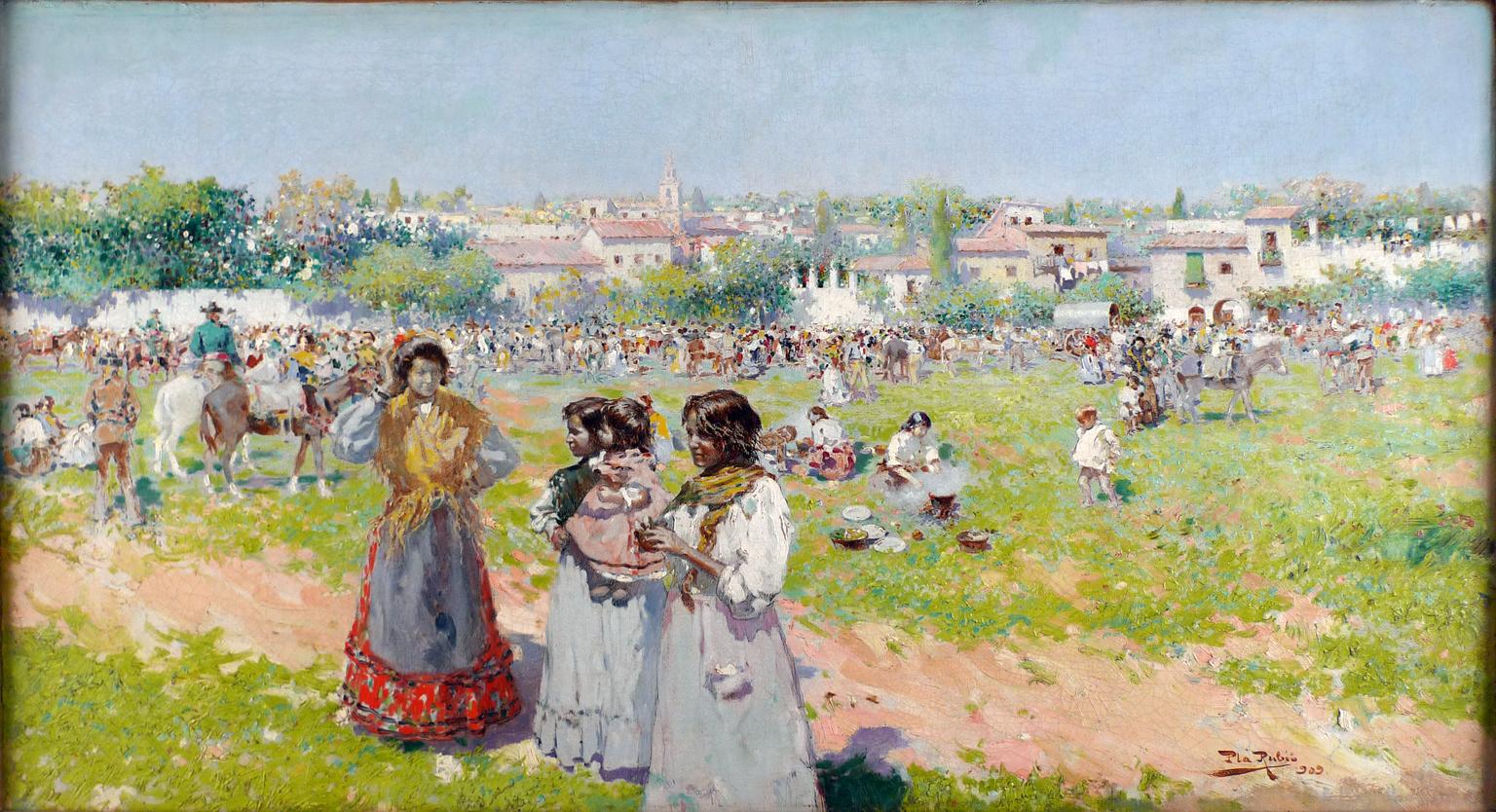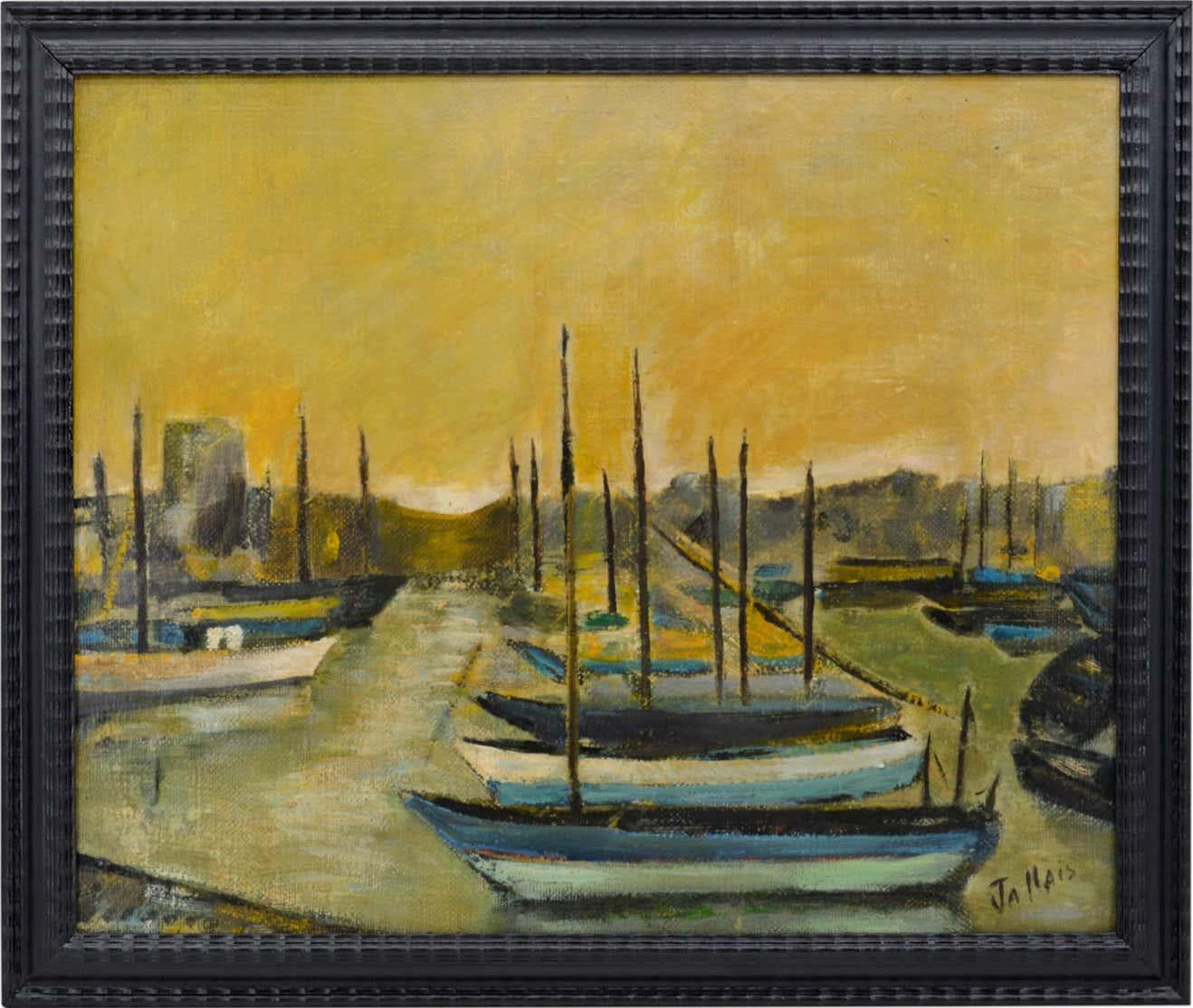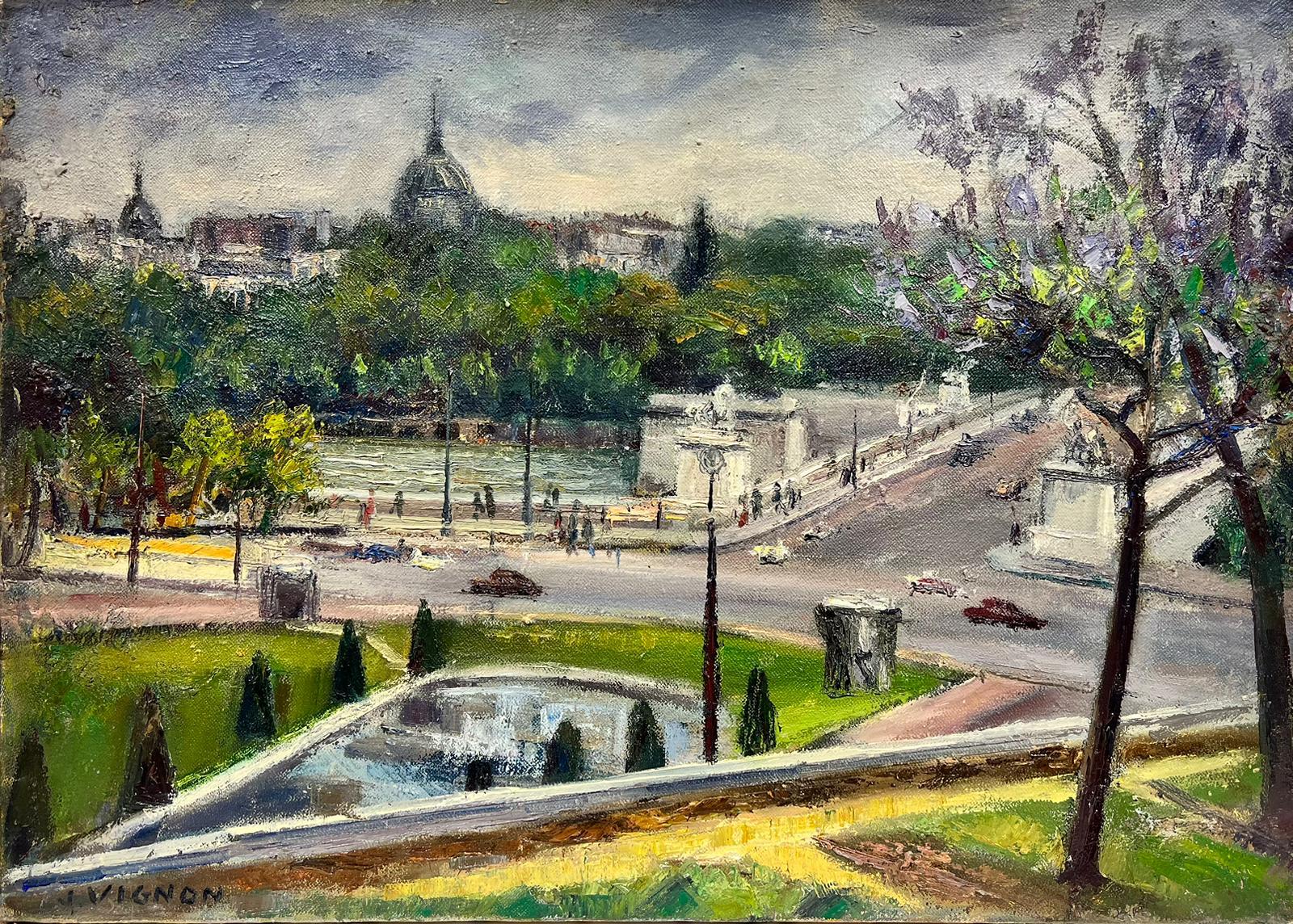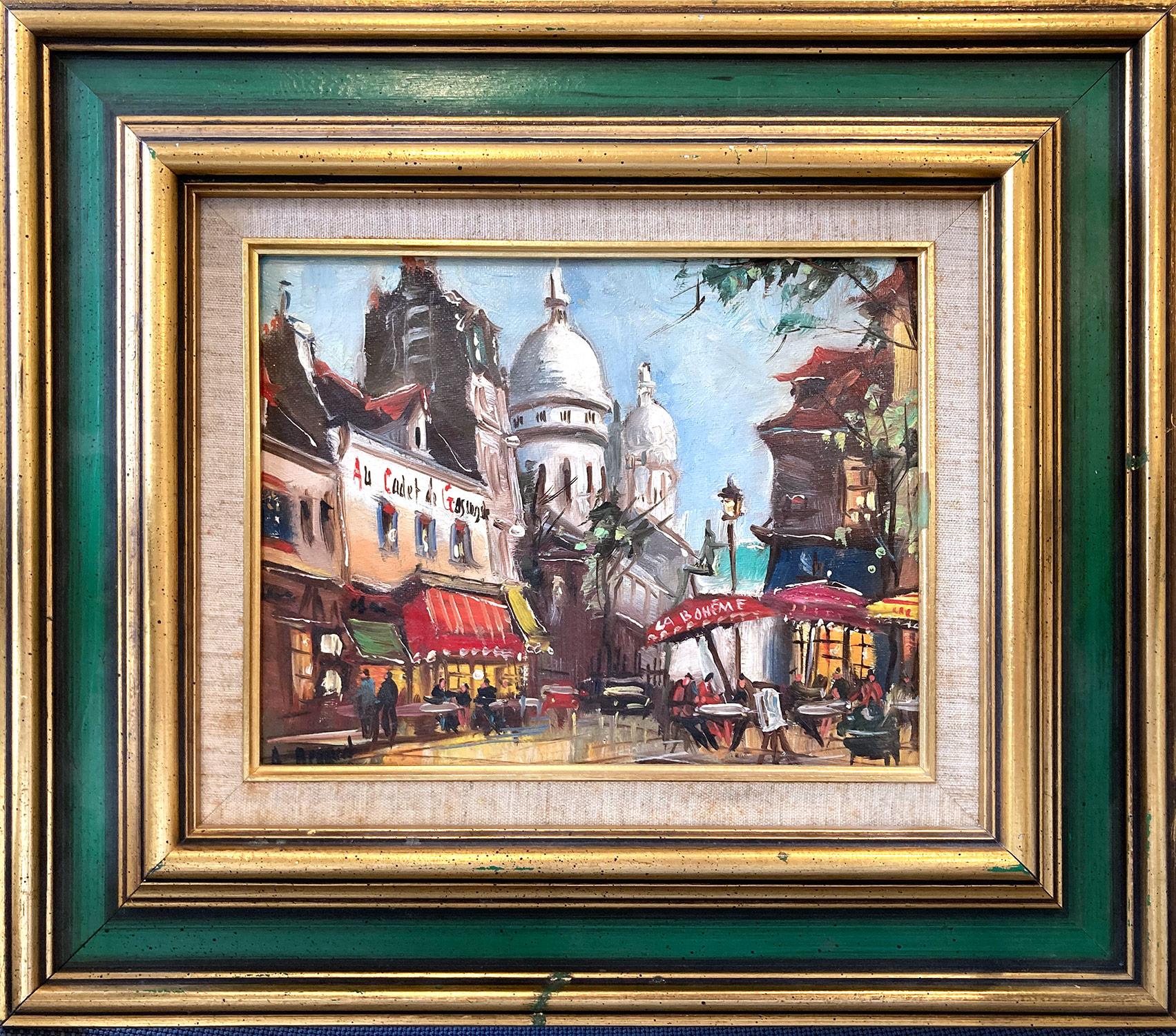Items Similar to La Rivière by PAULÉMILE PISSARRO - Post Impressionist Landscape Painting, River
Want more images or videos?
Request additional images or videos from the seller
1 of 8
Paul Emile PissarroLa Rivière by PAULÉMILE PISSARRO - Post Impressionist Landscape Painting, River1932
1932
About the Item
*UK BUYERS WILL PAY AN ADDITIONAL 20% VAT ON TOP OF THE ABOVE PRICE
La Rivière (The River) by PAULÉMILE PISSARRO (1884-1972)
Oil on canvas
92 x 73 cm (36 1⁄4 x 28 3⁄4 inches)
Signed and dated lower left Paulémile Pissarro 1932
Provenance
Private collection, London
This work is accompanied by a certificate of authenticity issued by Lélia Pissarro.
Artist biography
Paulémile Pissarro, Camille’s youngest son, was born in Eragny in 1884. He was brought up in the artistic environment of the family home there, and, encouraged by his father, began drawing at an early age. Paulémile’s godfather was Claude Monet, who became his teacher and close friend, particularly after Camille’s death in 1903.
In 1905, Paulémile exhibited at the Salon des Indépendants for the first time, showing an Impressionist landscape entitled Bords de l’Epte à Eragny. Although his father had supported his desire to be an artist, his mother was eager for him to learn a more practical trade. In 1908, Paulémile put aside his artistic pursuits to work as an automobile mechanic and test-driver, then as a lace and textile designer, allowing him only a little time to paint. While Paulémile was still working at the lace factory, his brother, Lucien, who lived in London, asked him to send over some watercolours, and the sale of these encouraged Paulémile to leave the factory and dedicate himself to painting.
By the 1920s, Paulémile had become an established Post-Impressionist artist in his own right, sharing a studio with Kees Van Dongen and spending the summer months escaping from Paris with him and Maurice de Vlaminck. In 1924, Paulémile moved to Lyons-la-Foret, a small town near Eragny, where he painted his surroundings with great pleasure, returning again and again to the placid waters of the River Epte, winding its way among willows, meadows and hills.
During the late 1920s and early 1930s, Paulémile reached the peak of his artistic development, arriving at the individual style for which he is best known. In 1930, he visited an area called Swiss Normandy and instantly fell in love with this part of the Calvados region, especially the River Orne that runs through the valley adjacent to the villages of Clécy and le Vey. The combination of blue hills and green meadows, separated by the calm waters of the river, offered Paulémile a new setting for his work. Paulémile moved in 1935 with his second wife, Yvonne Beaupel, to Clécy, where he would remain until his death.
In 1967, Paulémile had his first one-man show in the United States at Wally Findlay Galleries in New York. This led to widespread recognition and a degree of professional success that few Pissarro artists have known during their lifetime. Since his death in 1972, Paulémile’s paintings have been exhibited around the world, and interest in his work continues to grow.
- Creator:Paul Emile Pissarro (1884-1972, French)
- Creation Year:1932
- Dimensions:Height: 36.23 in (92 cm)Width: 28.75 in (73 cm)
- Medium:
- Movement & Style:
- Period:
- Condition:
- Gallery Location:London, GB
- Reference Number:1stDibs: LU261210185582
About the Seller
5.0
Recognized Seller
These prestigious sellers are industry leaders and represent the highest echelon for item quality and design.
Gold Seller
These expertly vetted sellers are highly rated and consistently exceed customer expectations.
Established in 1964
1stDibs seller since 2015
95 sales on 1stDibs
Typical response time: 8 hours
Associations
Society Of London Art Dealers
- ShippingRetrieving quote...Ships From: London, United Kingdom
- Return PolicyA return for this item may be initiated within 7 days of delivery.
More From This SellerView All
- Bords du Loing by Alfred Sisley - Oil, landscape paintingBy Alfred SisleyLocated in London, GB*THIS PRICE INCLUDES 5% IMPORT DUTY APPLICABLE IF THE WORK REMAINS IN THE UK ONLY. Bords du Loing by Alfred Sisley (1839-1899) Oil on canvas 46.1 x 55.7 cm (18¹/₈ x 21⁷/₈ inches) S...Category
1890s Post-Impressionist Landscape Paintings
MaterialsCanvas, Oil
- L'Île aux Oiseaux by Paulémile Pissarro - Landscape oil paintingBy Paul Emile PissarroLocated in London, GB*UK BUYERS WILL PAY AN ADDITIONAL 20% VAT ON TOP OF THE ABOVE PRICE L'Île aux Oiseaux by Paulémile Pissarro (1884-1972) Oil on canvas 61 x 47.6 cm (24 x ...Category
1930s Post-Impressionist Figurative Paintings
MaterialsCanvas, Oil
- La Voile Rose (Cognac) by H. Claude Pissarro - Post-Impressionist style paintingBy Hughes Claude PissarroLocated in London, GB*UK BUYERS WILL PAY AN ADDITIONAL 20% VAT ON TOP OF THE ABOVE PRICE La Voile Rose (Cognac) by H. Claude Pissarro (b. 1935) Oil on canvas 50 x 61 cm (19 ³/₄ x 24 inches) Signed lower...Category
21st Century and Contemporary Post-Impressionist Figurative Paintings
MaterialsCanvas, Oil
- Landscape painting by Paulémile Pissarro - 'Les Deux Arbres...'By Paul Emile PissarroLocated in London, GB*UK BUYERS WILL PAY AN ADDITIONAL 20% VAT ON TOP OF THE ABOVE PRICE Les deux arbres au bord de la rivière dans la forêt de Lyons by Paulémile Pissarro (1884-1972) Oil on canvas 65 x...Category
1950s Post-Impressionist Figurative Paintings
MaterialsCanvas, Oil
- Beau Temps à Clécy by H. Claude Pissarro - Post-Impressionist style paintingBy Hughes Claude PissarroLocated in London, GB*UK BUYERS WILL PAY AN ADDITIONAL 20% VAT ON TOP OF THE ABOVE PRICE Beau Temps à Clécy by H. Claude Pissarro (b. 1935) Oil on canvas 50 x 61 cm (19 ³/₄ x 24 inches) Signed lower rig...Category
21st Century and Contemporary Post-Impressionist Figurative Paintings
MaterialsCanvas, Oil
- La Rivière Orne et le Pain de S by PAULÉMILE PISSARRO - Oil, Post-ImpressionistBy Paul Emile PissarroLocated in London, GB*UK BUYERS WILL PAY AN ADDITIONAL 20% VAT ON TOP OF THE ABOVE PRICE La Rivière Orne et le Pain de Sucre by PAULÉMILE PISSARRO (1884-1972) Oil on canvas 54 x 65 cm (21 ¼ x 25 ⅝ inch...Category
1940s Post-Impressionist Landscape Paintings
MaterialsCanvas, Oil
You May Also Like
- Place de la République, 20th Century Oil on Canvas by Edouard Léon CortèsBy Édouard Leon CortèsLocated in Madrid, ESEDOUARD LÉON CORTÈS French, 1882 - 1969 PLACE DE LA RÉPUBLIQUE signed "EDOUARD CORTÈS." (lower right) oil on canvas 25-3/4 x 36-1/4 inches (65 x 91.5 cm.) framed: 33-1/2 x 44-1/4 inc...Category
1930s Post-Impressionist Figurative Paintings
MaterialsOil, Canvas
- "At the Annual Fair", an early 20th Century oil on canvas by Alberto Plá RubioLocated in Madrid, ESALBERTO PLA Y RUBIO Spanish, 1867 - 1937 AT THE ANNUAL FAIR signed & dated "Pla Rubio, 909" (lower right) oil on canvas 14 X 25-5/8 inches (35.5 X 65 cm.) ...Category
Early 1900s Post-Impressionist Landscape Paintings
MaterialsCanvas, Oil
- Oil on Canvas by Jallais, Boats in Port, 1960sLocated in Saint Amans des cots, FROil on canvas by Jallais, France, 1960s. Boats in port. In its pretty dark brown wooden frame. With frame: 68x58 cm - 26.8x22.8 inches, without frame: 61x50 cm - 24x19.7 inches. 12F ...Category
1960s Post-Impressionist Figurative Paintings
MaterialsCanvas, Oil
- 1950's French Post Impressionist Oil Painting Busy Paris River Scene & BridgeLocated in Cirencester, GloucestershireParis by Josine Vignon (French 1922-2022) signed oil painting on canvas, unframed canvas: 18 x 26 inches Colors: Green colors, grey, blue, brown and yellow Very good condition, th...Category
Mid-20th Century Post-Impressionist Landscape Paintings
MaterialsOil, Canvas
- "Place Du Tertre " Impressionist Oil Painting with Figures in Parisian VillageLocated in New York, NYThis painting is a tremendously vivid and alive street scene from Paris in the 20th Century, depicting The Place du Tertre. This square is in the 18th arrondissement of Paris, France. Only a few streets away from Montmartre's Basilica of the Sacré Cœur and the Lapin Agile...Category
Mid-20th Century Post-Impressionist Landscape Paintings
MaterialsOil, Canvas
- "Riding Through Town" Post-Impressionism French Village Oil Painting on CanvasBy Jacques ZuckerLocated in New York, NYA charming depiction of a village in Paris with figures and bicycle. The colors are breathtaking, as the impressionistic details are noted with thicker use of paint. The composition ...Category
20th Century Post-Impressionist Figurative Paintings
MaterialsOil, Canvas
Recently Viewed
View AllMore Ways To Browse
Small Impressionist Painting
Post Impressionist Paintings Paris
Post Impressionist Paintings Of Paris
Impressionist Man Painting
Impressionist Painting Of Rivers
Landscape Painting Switzerland
Swiss Landscape Paintings
Small Impressionist Landscapes
Sale Impressionist Painting
Trading Post
3 Sons Painting
Vintage Textile Painting
Normandy Landscape Painting
Paintings By Pissarro
1920s Impressionist Painting
Pissarro Camille
Paintings By Camille Pissarro
River Landscape Village




